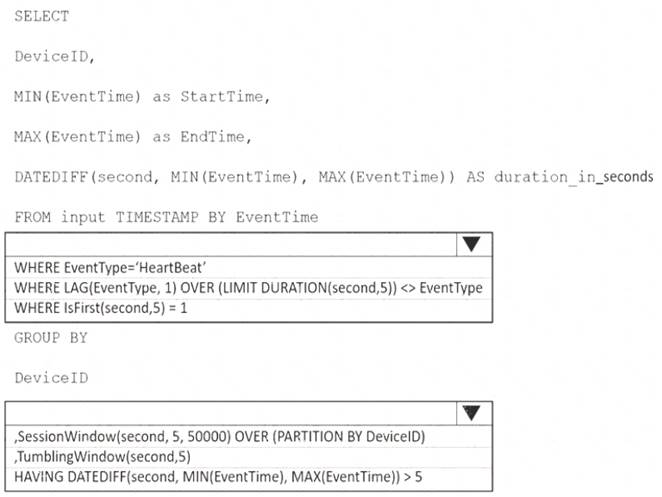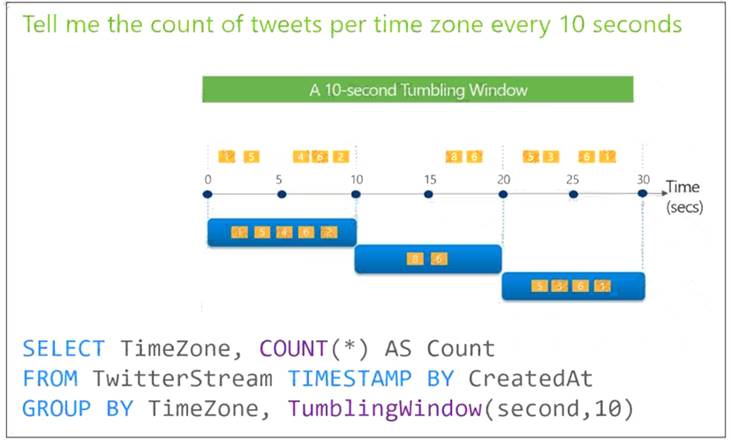- (Exam Topic 3)
You are implementing an Azure Stream Analytics solution to process event data from devices.
The devices output events when there is a fault and emit a repeat of the event every five seconds until the fault is resolved. The devices output a heartbeat event every five seconds after a previous event if there are no faults present.
A sample of the events is shown in the following table.
You need to calculate the uptime between the faults.
How should you complete the Stream Analytics SQL query? To answer, select the appropriate options in the answer area.
NOTE: Each correct selection is worth one point.
Solution:
Graphical user interface, text, application Description automatically generated
Box 1: WHERE EventType='HeartBeat' Box 2: ,TumblingWindow(Second, 5)
Tumbling windows are a series of fixed-sized, non-overlapping and contiguous time intervals.
The following diagram illustrates a stream with a series of events and how they are mapped into 10-second tumbling windows.
Timeline Description automatically generated
Reference:
https://docs.microsoft.com/en-us/stream-analytics-query/session-window-azure-stream-analytics https://docs.microsoft.com/en-us/stream-analytics-query/tumbling-window-azure-stream-analytics
Does this meet the goal?
Correct Answer:
A
- (Exam Topic 3)
Note: This question is part of a series of questions that present the same scenario. Each question in the series contains a unique solution that might meet the stated goals. Some question sets might have more than one correct solution, while others might not have a correct solution.
After you answer a question in this section, you will NOT be able to return to it. As a result, these questions will not appear in the review screen.
You plan to create an Azure Databricks workspace that has a tiered structure. The workspace will contain the following three workloads: A workload for data engineers who will use Python and SQL.
A workload for data engineers who will use Python and SQL. A workload for jobs that will run notebooks that use Python, Scala, and SOL.
A workload for jobs that will run notebooks that use Python, Scala, and SOL. A workload that data scientists will use to perform ad hoc analysis in Scala and R.
A workload that data scientists will use to perform ad hoc analysis in Scala and R.
The enterprise architecture team at your company identifies the following standards for Databricks environments: The data engineers must share a cluster.
The data engineers must share a cluster. The job cluster will be managed by using a request process whereby data scientists and data engineers provide packaged notebooks for deployment to the cluster.
The job cluster will be managed by using a request process whereby data scientists and data engineers provide packaged notebooks for deployment to the cluster. All the data scientists must be assigned their own cluster that terminates automatically after 120 minutes of inactivity. Currently, there are three data scientists.
All the data scientists must be assigned their own cluster that terminates automatically after 120 minutes of inactivity. Currently, there are three data scientists.
You need to create the Databricks clusters for the workloads.
Solution: You create a High Concurrency cluster for each data scientist, a High Concurrency cluster for the data engineers, and a Standard cluster for the jobs.
Does this meet the goal?
Correct Answer:
B
Need a High Concurrency cluster for the jobs.
Standard clusters are recommended for a single user. Standard can run workloads developed in any language: Python, R, Scala, and SQL.
A high concurrency cluster is a managed cloud resource. The key benefits of high concurrency clusters are that they provide Apache Spark-native fine-grained sharing for maximum resource utilization and minimum query latencies.
Reference: https://docs.azuredatabricks.net/clusters/configure.html
- (Exam Topic 3)
You are designing an enterprise data warehouse in Azure Synapse Analytics that will contain a table named Customers. Customers will contain credit card information.
You need to recommend a solution to provide salespeople with the ability to view all the entries in Customers. The solution must prevent all the salespeople from viewing or inferring the credit card information.
What should you include in the recommendation?
Correct Answer:
A
SQL Database dynamic data masking limits sensitive data exposure by masking it to non-privileged users. The Credit card masking method exposes the last four digits of the designated fields and adds a constant string as a prefix in the form of a credit card.
Example: XXXX-XXXX-XXXX-1234
Reference:
https://docs.microsoft.com/en-us/azure/sql-database/sql-database-dynamic-data-masking-get-started
- (Exam Topic 3)
You have an enterprise data warehouse in Azure Synapse Analytics.
You need to monitor the data warehouse to identify whether you must scale up to a higher service level to accommodate the current workloads
Which is the best metric to monitor?
More than one answer choice may achieve the goal. Select the BEST answer.
Correct Answer:
C
- (Exam Topic 2)
What should you do to improve high availability of the real-time data processing solution?
Correct Answer:
A
Guarantee Stream Analytics job reliability during service updates
Part of being a fully managed service is the capability to introduce new service functionality and improvements at a rapid pace. As a result, Stream Analytics can have a service update deploy on a weekly (or more frequent) basis. No matter how much testing is done there is still a risk that an existing, running job may break due to the introduction of a bug. If you are running mission critical jobs, these risks need to be avoided. You can reduce this risk by following Azure’s paired region model.
Scenario: The application development team will create an Azure event hub to receive real-time sales data, including store number, date, time, product ID, customer loyalty number, price, and discount amount, from the point of sale (POS) system and output the data to data storage in Azure
Reference:
https://docs.microsoft.com/en-us/azure/stream-analytics/stream-analytics-job-reliability